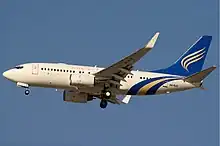| Boeing Business Jets | |
|---|---|
| Role | Business jet |
| Manufacturer | Boeing Commercial Airplanes |
| First flight | September 4, 1998 |
| Introduction | 1999 |
| Produced | 1998–present |
| Number built | +250 (as of December 31, 2021) (including BBJ1, BBJ2, BBJ3, 747BBJ, 757BBJ, 767BBJ, 777BBJ & 787BBJ) |
Boeing Business Jets (BBJ) are versions of Boeing's jet airliners with modifications to serve the private, head of state, and corporate jet market. In 1996, Phil Condit, president of Boeing, and Jack Welch, chairman and CEO of General Electric, sketched out their ideal business jet – a high-performance derivative of the Boeing 737 Next Generation, capable of flying more than 6,000 nautical miles nonstop and offering more cabin space than traditional long-range business jets. The first BBJ, based on the 737-700, rolled out on July 26, 1998; and had its first flight on September 4, 1998.
Boeing expanded the BBJ brand to include configurations based on the 737 MAX, 777, 777X, 787 Dreamliner and 747-8 Intercontinental, which are known as BBJ 737 MAX, BBJ 777, BBJ 777X, BBJ 787, and BBJ 747-8, respectively. Boeing currently produces the BBJ 737-7, BBJ 737-8, BBJ 737-9, BBJ 787-8, and BBJ 787-9. The BBJ 777X will be available once it is certified by the FAA.
As many types of customers may order one of the jets, BBJs can be uniquely customized for the needs of each owner. Since its introduction as a separate group, 250 BBJs have delivered of 260 orders.
BBJs typically seat between 19 and 50 passengers with bespoke configurations that can include bedrooms, fully-fitted bathrooms, conference and dining areas, living areas, a small fitness center, and more. All models of BBJs are delivered by Boeing without an interior fitted so the customer can add the interior that they want.
After the launch of the BBJ, Airbus followed suit with the launch of the Airbus ACJ derived from its A319 airliner, followed by the larger A320 and the smaller A318 Elite. Other smaller competitors include the Embraer Lineage, the Bombardier Global Express, the Gulfstream G550 and the Gulfstream G650.
Models
Current production models
Narrow body

The primary product offered by Boeing Business Jets is the BBJ 737 MAX family. Launch was announced on April 2, 2014, and the first delivery occurred on October 15, 2018. The BBJ MAX replaces and improves upon the original BBJ 737 family, featuring a lower 6,500 ft cabin altitude for enhanced passenger comfort as well as a 15% reduction in fuel burn and an increase in range to over 6,000 nmi brought by new CFM LEAP-1B engines, improved aerodynamics, auxiliary fuel tanks, and other systems.

The BBJ MAX is based on the Boeing 737 MAX family of aircraft. Unlike most commercial 737s, the BBJ MAX is fitted with retractable airstairs to allow independent operations at remote airfields. BBJ MAX aircraft are also equipped with all of the optional extra features available on commercial 737s, as well as the highest takeoff weight certification and maximum available engine thrust option.
The BBJ MAX also benefits from its commercial counterparts. Direct operating costs are estimated at $5,200 to $5,600 per hour, which is lower than many purpose-built business jets of similar size. This efficiency is partly enabled by a low utilization maintenance program, which lengthens the distance between maintenance intervals for BBJ operators – major checks occurring every four years, and heavy checks only once every 12 years.
- BBJ 737-7 (BBJ MAX 7) is a variant of the Boeing 737 MAX 7. It is 6 ft 4 in (1.93m) longer than the original BBJ1 and features a range of 6,600 nmi (12,225 km), which is 445 nmi (825 km) further than the BBJ1. The 737-7 is currently undergoing certification.
- BBJ 737-8 (BBJ MAX 8) is a variant of the Boeing 737 MAX 8. It first flew on April 16, 2018, and was first delivered in October of that year. The middle member of the family offers a strong combination of size and range.
- BBJ 737-9 (BBJ MAX 9) is a variant of the Boeing 737 MAX 9 and is the largest member of the BBJ MAX family, offering a cabin floor area of 1,120 sq ft (104.1 m2). The first BBJ 737-9 was delivered green on August 18, 2021.
In 2023, the equipped price of the BBJ MAX 7 was $101.5M, $110.5M for the MAX 8, and $118.5M for the MAX 9.[1]
Specifications
| Variant | BBJ MAX 7 | BBJ MAX 8 | BBJ MAX 9 |
| Cabin | 884 sq ft / 82.1 m2 | 1,025 sq ft / 95.2 m2 | 1,120 sq ft / 104.1 m2 |
| Cargo | 274 cu ft / 7.8 m³ | 593 cu ft / 16.8 m³ | 775 cu ft / 21.9 m³ |
| Length | 116 ft 8 in / 35.6 m | 129 ft 8 in / 39.6 m | 138 ft 2 in / 42.1 m |
| Span × Height | 117 ft 10 in / 35.9 m × 40 ft 4 in / 12.3 m | ||
| MTOW | 177,000 lb / 80.3 t | 181,200 lb / 82.2 t | 194,700 lb / 88.3 t |
| Max Payload | 32,500 lb (14.7 t) | 35,200 lb (16.0 t) | 38,800 lb (17.6 t) |
| OEW | 106,200 lb (48.2 t) | 110,200 lb (50.0 t) | 117,700 lb (53.4 t) |
| Furnishings | 15,500 lb (7.0 t) | 18,000 lb (8.2 t) | 21,000 lb (9.5 t) |
| MEW | 90,700 lb (41.2 t) | 92,200 lb (41.8 t) | 96,700 lb (43.9 t) |
| Fuel capacity | 10,103 US gal
(38,244 liters) |
10,381 US gal
(39,296 liters) |
10,910 US gal
(41,299 liters) |
| Engines (2×) | CFM International LEAP | ||
| Range (8 pax) | 6,600 nmi (12,225 km) | 6,465 nmi (11,975 km) | 6,355 nmi (11,770 km) |
Wide Body
Based on Boeing's commercial 787 Dreamliner, the BBJ 787 is a large business jet featuring a composite airframe and low cabin altitude system. It is partnered with the largest passenger and business aviation aircraft currently produced, the 777X. The BBJ 777X was announced on Dec. 10, 2018, and it will have the capability to fly more than halfway around the world without stopping, the longest of any current business jet.
BBJ 787 Family: Based on the successful Boeing 787 Dreamliner family, the BBJ 787−8 and the BBJ 787-9 are long-range aircraft, with ranges of 9,960 and 9,475 nmi (18,445 and 17,550 km), respectively, with 25 passengers. Eighteen were ordered through September 2022 with 16 delivered.
BBJ 777X Family: Boeing launched BBJ variants of the 777X at the Middle East Business Aviation Association Show in December 2018. The BBJ 777-8 and 777-9 will have ranges of 11,835 and 11,330 nmi (21,920 and 20,985 km), respectively, with 25 passengers. Now the largest business jets in the world, these aircraft have cabin areas of 3,256 and 3,689 sq. ft. (302.5 and 342.7 sq m) cabin. The cabin area of the 777-9 is larger than the main deck of a 747-400 and will be 30% cheaper to operate per hour. The 777X is currently undergoing certification before entry into service, currently expected in 2025.
Specifications
| Variant | BBJ 787-8 | BBJ 787-9 | BBJ 777-8 | BBJ 777-9 |
| Cabin | 2,340 sq.ft
/ 217.3 m2 |
2,688 sq.ft / 249.7 m2 | 3,256 sq.ft / 302.5 m2 | 3,689 sq.ft / 342.7 m2 |
| Cargo | 4,397 cu.ft / 124.5 m³ | 5,452 cu.ft / 154.4 m³ | 6,332 cu.ft / 179.3 m³ | 7,705 cu.ft / 218.2 m³ |
| Length | 186 ft 1 in (56.7 m) | 206 ft 1 in (62.8 m) | 229 ft / 69.8 m | 251 ft 9 in / 76.7 m |
| Span | 197 ft 3 in (60.1 m) | 235 ft 5 in / 71.8 m | ||
| Height | 55 ft 6 in (16.9 m) | 55 ft 10 in (17.0 m) | 63 ft 11in / 19.5 m | 64 ft 1 in / 19.5 m |
| MTOW | 502,500 lb / 227.9 t | 560,000 lb / 254.0 t | 775,000 lb / 351.5 t | |
| Max Payload | 78,000 lb (35.3 t) | 104,600 lb (47.4 t) | 138,500 lb (62.8 t) | 147,000 lb
(66.6 t) |
| OEW | 277,000 lb (125.7 t) | 295,400 lb (134.0 t) | 402,500 lb (182.6 t) | 415,000 lb (188.3 t) |
| Furnishings | 40,000 lb (18.1 t) | 45,000 lb (20.4 t) | 55,000 lb (25.0 t) | 65,000 lb (29.5 t) |
| MEW | 237,000 lb (107.6 t) | 250,400 lb (113.6 t) | 347,500 lb (157.6 t) | 350,000 lb (158.8 t) |
| Fuel capacity | 33,340 US gal (126,206 liters) | 33,380 US gal (126,357 liters) | 52,136 US gal / 197,356 liters | |
| Engines | GEnx-1B or Rolls-Royce Trent 1000 | General Electric GE9X | ||
| Range (25 pax) | 9,960 nmi (18,445 km) | 9,475 nmi (17,550 km) | 11,835 nmi (21,920 km) | 11,330 nmi (20,985 km) |
Out-of-production models
Narrow-body The first BBJ (often referred to as “BBJ” or “BBJ1”) was based on the Boeing 737-700 with a stronger wing and had the landing gear from the Boeing 737-800. It offered up to nine auxiliary belly fuel tanks to extend the aircraft's range to over 6,000 nautical miles (11,000 km). Aviation Partners winglets became standard on the BBJ, giving it a 5% range boost.
In 2002, the BBJ2, based on the 737-800, was introduced, offering a 25% longer cabin with a similar range with five tanks. In 2009, the BBJ3 was introduced based on the even longer Boeing 737-900.
During its 20 years of production, 150 BBJs entered service, triple the initial forecast of 50. Boeing delivered the last BBJ based on the 737NG in 2021.
- BBJ (retroactively referred to as the BBJ1) was based on the 737-700 and formed the basis for the 737-700ER. This was the initial and most popular variant.
- BBJ2 was based on the 737-800.
- BBJ3 was based on the 737-900ER.
- BBJ C was based on the 737-700C. This aircraft features the ability to "quick change" between a configuration for VIP passengers and for cargo. In the United States Navy service, this is known as the C-40A Clipper.
Wide-body
Boeing previously offered BBJs based on the 747-8 Intercontinental, the final model of the venerable 747 family, and BBJs based on the 777 aircraft.
- BBJ 747: The 2nd largest business jet ever produced, it offered over 4,700 sq ft (440 m2) of cabin area, across the main and upper decks. It had a range of 8,875 nmi (16,436 km) with 100 passengers, 17 were ordered through September 2022, all delivered.
- BBJ 777: The BBJ 777-200LR and BBJ 777-300ER, based on the commercial 777s of those variants, were offered prior to the introduction of the BBJ 777X family. They offered ranges of 10,030 and 9,300 nmi (18,580 and 17,220 km) with 75 passengers, respectively. Seventeen were ordered, and all have been delivered.
Operators
_CBR_Gilbert-2.jpg.webp)
.jpg.webp)
_(Boeing_Business_Jet_3)_9K-GCC.jpg.webp)
Private
BBJs were initially operated by Fortune 100 companies like Aramco and Tracinda, NetJets, and casinos like the Las Vegas Sands. However, the 2008 recession put ultra-large jets under scrutiny, and they were divested by many companies including The Limited, General Electric, and Occidental Petroleum. Similarly, Xi Jinping's anti-corruption campaign reduced the conspicuous consumption of private jets in China. BBJs are now operated by private firms and individuals: Fresno's Assemi Group, Miami's Crescent Heights, Wichita's Town & Country Food Market, Funair Corp., toymaker Ty, Fortress Transportation & Instructure, Jeffrey Katzenberg, John Travolta, Steven Spielberg, Washington Corp., Tutor Saliba or pachinko king Hideyuki Busujima, with many registrations hiding their owners’ identities.[2]
State VIP users
Most BBJs are operated by governments for VIP transport in U.S., Australia and Africa, plus Colombia, Turkey, India, UAE, Jordan, Malaysia, South Africa and Tunisia; or Middle East oil barons like Abu Dhabi, Dubai and Saudi Arabia royalty.[2]
.svg.png.webp) Australia
Australia- Royal Australian Air Force (2)
- No. 34 Squadron RAAF leased 737 BBJ1 for VIP transport
 Belarus
Belarus- Belarus Air Force (2)
- Boeing 767-32K (EW-001PB) and BBJ2 for Government VIP flight[3]
 Colombia
Colombia- Colombian Air Force (1)
- Grupo de Vuelos Especiales 82 Escuadrón de Transporte Especial 821 for VIP transport
 India
India- Indian Air Force (3)
- Air HQ Communication Squadron for Government VIP use
 Indonesia
Indonesia- Indonesian Air Force (1)
- 17th Air Squadron
- BBJ2 for Presidential & Government VVIP flight[4]
 Kazakhstan
Kazakhstan- Armed Forces of the Republic of Kazakhstan (1)
 Kuwait
Kuwait- Kuwait Air Force (2)
 Madagascar
Madagascar- Presidency (1)
 Malaysia
Malaysia- Royal Malaysian Air Force (1)
- 1st Division 2 Squadron for VIP
 Mexico
Mexico- Mexican Air Force (1)
- General Coordination of the Presidential Air Transport Unit - 787 for government VIP flight, currently stored.
 Morocco
Morocco- Royal Moroccan Air Force (2)
 Netherlands
Netherlands- Royal Netherlands Air Force (1)[5]
 Niger
Niger- Government of Niger (1)
- 5U-BAG for government VIP flight stored since 2014.[6]
 Nigeria
Nigeria- Nigerian Air Force (1)
- NAF Mobility Command
 Poland
Poland- Polish Air Force
- * 3rd Transport Aviation Wing Aviation Squadron for government VIP flight, beginning in 2020 (2 BBJ2)[7]
 Qatar
Qatar- Qatar Amiri Flight (1)
- sold to Moroccan Government in 2010
 South Africa
South Africa- South African Air Force (1)
- 21 Squadron SAAF for VIP transport
 Tunisia
Tunisia- Republic of Tunisia Government (1)
 Turkey
Turkey- Republic of Turkey (1)
- Boeing 747-8ZV (BBJ) for VIP transport
 United Arab Emirates
United Arab Emirates- Presidential Flight (9), Royal Jet (6) BBJ1 for Government VIP flight[8]
Orders and deliveries
| Through December 2022[9] | |||||||
| Aircraft | 737 | 757 | 767 | 777 | 787 | 747 | Total |
| Orders | 198 | 5 | 8 | 17 | 18 | 17 | 263 |
| Deliveries | 190 | 5 | 8 | 17 | 16 | 17 | 253 |
| In service | 188 | 5 | 8 | 16 | 14 | 13 | 244 |
See also
- Environmental impact of aviation – Effect of emissions from aircraft engines
Related development
Aircraft of comparable role, configuration, and era
Related lists
Notes
References
- ↑ "Purchase planning handbook - Ultra long-range Jets table". Business & Commercial Aircraft. Second Quarter 2023.
- 1 2 Fred George (Jan 7, 2019). "Boeing Business Jet: Why Go Big? Because You Can". Business & Commercial Aviation.
- ↑ "EW-001PB Belarus Government Boeing 767-300".
- ↑ tjs (14 April 2014). "RI 'Air Force One' will not be armed". Jakarta Post. Retrieved 17 January 2015.
- ↑ "Dutch to replace Royal transport with 737 BBJ". FlightGlobal. 11 April 2017. Retrieved 12 April 2018.
- ↑ "5U-BAG Niger Government Boeing 737-200C".
- ↑ "Polish gov't orders three VIP-configured B737NextGens". ch-aviation.com. Retrieved 12 April 2018.
- ↑ "Boeing Business Jet 2 (BBJ2) - Aerospace Technology".
- ↑ "Commercial". Boeing. Retrieved 2022-11-30.
